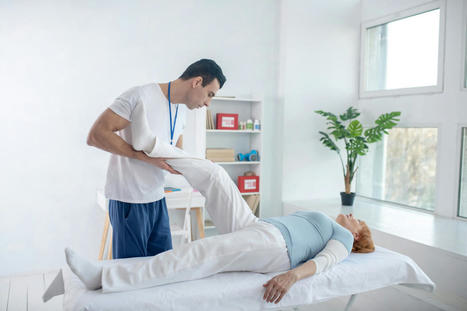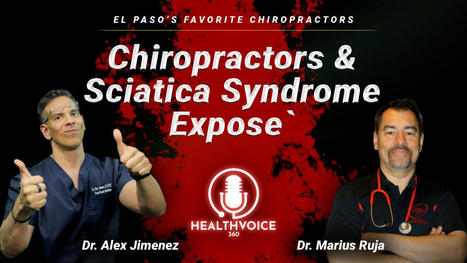 Your new post is loading...
 Your new post is loading...
Hamstring syndrome is a condition where the sciatic nerve gets pinched between the hamstring muscles and the pelvic bone or by the tissue bands that connect the hamstring muscles causing compression on and around the nerve. It is seen in individuals that play sports that involve running, kicking, or jumping, in middle-aged individuals engaged in daily activities that have suffered falls, and in individuals that sit for many hours. Chiropractic care, massage, and decompression therapy can relieve the symptoms, release the trapped nerve, relax and stretch the muscles, and restore function. Hamstring Muscles Trapped Sciatic Nerve Three muscles make up the hamstrings in the back of the thigh. The sciatic nerve runs from the low back down the leg into the foot. A trapped sciatic nerve can cause various symptoms and sensations in the back of the leg, hip, buttock, and foot. It may hurt to sit down or stretch the legs out, and there is usually tightness in and/or around the buttock and back of the leg. The symptoms typically recede when lying on your back. Cause - Regular wear and tear on the back muscles and hamstrings can contribute to the condition.
- Often the sciatic nerve and/or the sheath surrounding the sciatic nerve gets trapped and irritated as it travels around the ischial tuberosity. The ischial tuberosities are known as the sit bones.
- The area where the sciatic nerve runs down the back of the leg can become narrowed, leading to nerve irritation and stinging, numbing, and tingling sensations.
- The injury often happens during sudden, quick, forceful movements that overstretch the tendons and/or muscles but can also happen during slow movements.
- Movement agitates the pulling and rubbing of the nerve on the muscles.
- A non-painful pull or pop of the hamstrings can cause the muscles to spasm and wrap around the nerve.
Symptoms Symptoms usually include the following: - Leg pain that worsens when sitting.
- Intense electrical shooting pain that makes it hard to stand or move.
- Difficulties moving the leg or foot.
- Numbness and weakness in and around the leg.
- Tingling or burning sensations running down the leg.
- Persistent pain on one side of the lower back.
Chiropractic Care Chiropractic treatment can relieve the symptoms and release the trapped nerve. Treatment includes: - Accurate Diagnosis - A chiropractor will examine and review physical activity, work, and medical history.
- Ice and Heat therapies will stop the swelling and increase blood flow.
- Massage therapy relaxes the muscles and increases circulation.
- Decompression therapy incrementally and gently stretches the body.
- Chiropractic adjustments realign and reset the body.
- Targeted stretches and exercises will keep the muscles loose and increase strength.
- Nutritional recommendations will help reduce inflammation and prevent flare-ups.
General Disclaimer * The information herein is not intended to replace a one-on-one relationship with a qualified healthcare professional or licensed physician and is not medical advice. We encourage you to make healthcare decisions based on your research and partnership with a qualified healthcare professional. Our information scope is limited to chiropractic, musculoskeletal, physical medicines, wellness, sensitive health issues, functional medicine articles, topics, and discussions. We provide and present clinical collaboration with specialists from a wide array of disciplines. Each specialist is governed by their professional scope of practice and their jurisdiction of licensure. We use functional health & wellness protocols to treat and support care for the injuries or disorders of the musculoskeletal system. Our videos, posts, topics, subjects, and insights cover clinical matters, issues, and topics that relate to and directly or indirectly support our clinical scope of practice.* Our office has reasonably attempted to provide supportive citations and identified the relevant research study or studies supporting our posts. We provide copies of supporting research studies available to regulatory boards and the public upon request. We understand that we cover matters that require an additional explanation of how it may assist in a particular care plan or treatment protocol; therefore, to further discuss the subject matter above, don't hesitate to get in touch with Dr. Alex Jimenez or contact us at 915-850-0900. Dr. Alex Jimenez DC, MSACP, CCST, IFMCP*, CIFM*, ATN* email: coach@elpasofunctionalmedicine.com Licensed in: Texas & New Mexico* References Lohrer, Heinz, et al. "Nerve entrapment after a hamstring injury." Clinical journal of sports medicine: official journal of the Canadian Academy of Sports Medicine vol. 22,5 (2012): 443-5. doi:10.1097/JSM.0b013e318257d76c Mattiussi, Gabriele, and Carlos Moreno. "Treatment of proximal hamstring tendinopathy-related sciatic nerve entrapment: presentation of an ultrasound-guided "Intratissue Percutaneous Electrolysis" application." Muscles, ligaments and tendons journal vol. 6,2 248-252. 17 Sep. 2016, doi:10.11138/mltj/2016.6.2.248 McGregor, Catriona, et al. "Traumatic and overuse injuries of the ischial origin of the hamstrings." Disability and rehabilitation vol. 30,20-22 (2008): 1597-601. doi:10.1080/09638280701786138 Saikku, Kari, et al. "Entrapment of the proximal sciatic nerve by the hamstring tendons." Acta orthopaedica Belgica vol. 76,3 (2010): 321-4.
The hamstring muscles are three muscles in the back of the thigh. The sciatic nerve goes through or around and down the legs into the feet. Hamstring syndrome is a condition where injury or spasm apply pressure compressing the sciatic nerve. - The nerve can become pinched between the hamstring muscles and the pelvic bone or the band of tissue that connects the hamstring muscles.
- This can cause discomfort, tingling, numbness, and pain down the back of the leg, hip, buttock, and into the foot.
- Pain can present when sitting down or stretching the hamstrings.
- Pain reduces when lying flat on the back.
Hamstring syndrome This condition could be the result of wearing and tearing to the back muscles and hamstring muscles. It is often seen in individuals that play sports involving running, kicking, and/or jumping. But it can happen to anyone from some awkward leg motion causing the muscles to spasm that can twist around the sciatic nerve or pull on it, causing various symptoms. A doctor or chiropractor will diagnose the condition by examining the symptoms, physical activities, and leg. Most individuals diagnosed with hamstring syndrome report discomfort or pain where they sit down. The pain gradually worsens when performing physical activities, regularly sitting, and when flexing the knee. Hamstring syndrome usually gets better within a few weeks with proper rest and home care. A doctor or chiropractor will recommend exercises and stretches to strengthen the muscles. Home care - Ask the doctor or chiropractor about taking over-the-counter pain medication:
- Acetaminophen - Tylenol
- Ibuprofen - Advil, Motrin
- Naproxen - Aleve
- Read and follow all label instructions.
- Use an ice pack on the pain area for 10 to 20 minutes at a time.
- Try to do this every 1 to 2 hours for 3 days or until the swelling goes down.
- After 2 or 3 days, if the swelling is gone, apply heat.
- Use a warm water bottle, heating pad, or warm cloth over the area.
- Avoid sitting if possible, unless it feels better than standing.
- Take short walks to keep the muscles stretched.
- Don't do anything that causes symptoms to worsen.
- Return to normal physical activities slowly.
- If symptoms do not improve, then contact a doctor or chiropractor.
Short-term effects of coffee - Coffee increases short-term blood pressure slightly.
- Caffeine falls under stimulants, or substances that excite the systems throughout the body.
- Ingesting caffeine can cause the body to experience increased excitement, especially in the cardiovascular system.
- This excitement causes the heart rate and blood pressure to rise
- Then it lowers back down to baseline levels for most healthy individuals.
- It is recommended to drink coffee in moderation, safe for individuals with pre-existing cardiovascular conditions.
General Disclaimer * The information herein is not intended to replace a one-on-one relationship with a qualified health care professional, licensed physician, and is not medical advice. We encourage you to make your own health care decisions based on your research and partnership with a qualified health care professional. Our information scope is limited to chiropractic, musculoskeletal, physical medicines, wellness, sensitive health issues, functional medicine articles, topics, and discussions. We provide and present clinical collaboration with specialists from a wide array of disciplines. Each specialist is governed by their professional scope of practice and their jurisdiction of licensure. We use functional health & wellness protocols to treat and support care for the injuries or disorders of the musculoskeletal system. Our videos, posts, topics, subjects, and insights cover clinical matters, issues, and topics that relate to and support, directly or indirectly, our clinical scope of practice.* Our office has made a reasonable attempt to provide supportive citations and has identified the relevant research study or studies supporting our posts. We provide copies of supporting research studies available to regulatory boards and the public upon request. We understand that we cover matters that require an additional explanation of how it may assist in a particular care plan or treatment protocol; therefore, to further discuss the subject matter above, please feel free to ask Dr. Alex Jimenez or contact us at 915-850-0900. Dr. Alex Jimenez DC, MSACP, CCST, IFMCP*, CIFM*, ATN* email: coach@elpasofunctionalmedicine.com Licensed in: Texas & New Mexico* References de Ridder, Roel et al. “Neurodynamic sliders promote flexibility in tight hamstring syndrome.” European journal of sports science vol. 20,7 (2020): 973-980. doi:10.1080/17461391.2019.1675770 Matsuda, Dean K. “Editorial Commentary: Proximal Hamstring Syndrome: Another Pain in the Buttock.” Arthroscopy: the journal of arthroscopic & related surgery: official publication of the Arthroscopy Association of North America and the International Arthroscopy Association vol. 34,1 (2018): 122-125. doi:10.1016/j.arthro.2017.08.260 Park, Jung Wee et al. “Deep gluteal syndrome as a cause of posterior hip pain and sciatica-like pain.” The bone & joint journal vol. 102-B,5 (2020): 556-567. doi:10.1302/0301-620X.102B5.BJJ-2019-1212.R1
Piriformis Syndrome is a painful condition that occurs when the piriformis muscle is tight and intrudes upon the sciatic nerve in the buttocks. Piriformis Syndrome is a painful condition that occurs when the small muscle located deep within the buttocks, known as the piriformis muscle, becomes tight and intrudes upon the sciatic nerve in the buttocks. Causing pain and tenderness and sometimes numbness in the buttocks, piriformis syndrome pain may also radiate down the sufferer’s leg, and in some cases, even into the calf. The piriformis muscle performs the essential function of rotating the leg outwards. Unfortunately, once an individual has suffered from piriformis syndrome, the condition can recur periodically, usually brought on by too much exercise or sitting for a long time without stretching. Whatever the initial cause, piriformis syndrome treatment options are vital in relieving the painful symptoms and healing the condition. Hands on therapy, used with other types of treatment or on their own, these types of therapies are popular because of their effectiveness, as well as the fact they are drug-free ways to gain relief from the pain. Massage is a commonly used therapy for piriformis syndrome, as it helps increase blood flow to the area. The physical therapist can manipulate the area to relieve the tightness of the muscle.
|
Identification of piriformis syndrome or sciatica requires proper testing and examination. The piriformis muscle begins at the sacrum near the sacroiliac joint and is attached to the femur/thigh bone at the outer area of the hip. The sciatic nerve passes typically under or through the muscle before going down the back of the thigh. The piriformis helps to turn the hip outward and bring the thigh outward to one side while the hip is bent. This could be when raising the knee and bringing the leg out. An example is stepping out of a car. The muscle also helps to stabilize when walking, running, and standing. Individuals with the sciatic nerve passing through the piriformis have an increased chance of developing piriformis syndrome. It can also be called piriformis sciatica since it is not true sciatica. Symptoms Piriformis syndrome does not always present the same way. Common symptoms include pain, tingling, and numbness in the buttocks that becomes worse when sitting. Other symptoms can include: - Pain when sitting, standing, or walking
- Pain when getting up from a seated/squatting position
- Pain in the sacroiliac joint
- Pain and/or pins and needles, burning, tingling, or itching sensation
- Movement helps to reduce pain symptoms
- Numbness in the foot
Many of these symptoms can be mistaken for sciatica. This is why proper testing is necessary to provide the appropriate treatment, otherwise, the condition could be made worse or create new injuries. Causes - Primary piriformis syndrome happens when there is a splitting of the piriformis muscle, the sciatic nerve, and/or the sciatic nerve does not run along the normal path.
- Secondary piriformis syndrome is more common and is caused by inflammation of the soft tissues, muscle spasms, or both. And the result is nerve compression.
- Direct trauma to the buttock area can definitely cause inflammation, scarring, and contraction of the piriformis muscle. This could be the result of an automobile accident, or a fall.
- The most common cause is a progressive tightening of the muscle brought on from a weakened piriformis muscle.
Testing Because of the close relation between piriformis syndrome and sciatica, a chiropractic medical professional will perform various tests to determine if symptoms are spinal disc-related or caused by the sciatic nerve getting pinched, or impinged by the piriformis muscle. A chiropractor will examine the low back, hip, pelvis, sacroiliac joint, walking gait, posture, and leg length. They will test various body reflexes as well. Other tests can include: - Palpation/manipulation of the piriformis muscle
- A Straight leg raise will be done to see if there is localized pain when pressure is applied to the piriformis muscle and the tendon. The chiropractor will flex the hip at a 90-degree angle and extend/straighten the knee.
- A Freiberg test will be done to see if pain presents around the piriformis or reproduces symptoms.
- The Pace maneuver test looks for pain and/or weakness during rotation of the hip when sitting.
- The F.A.I.R test stands for flexion, adduction, and internal rotation. This test has the individual lie on the non-affected side while the chiropractor guides the painful leg into hip flexion, turns it in toward the body, and gently turns the lower leg outward.
- The Beatty maneuver tests for pain while lying on the non-affected side, and the chiropractor elevates the flexed symptomatic leg.
- Testing for pain or weakness in specific positions is conducted usually for one-minute or when the individual experiences symptoms.
In addition to a physical exam, a chiropractor will utilize imaging scans to rule out any other causes. This can include X-rays, MRI, or CT scan. Once the source has been diagnosed treatment can begin. Many individuals choose to wait and see what happens, hoping the problem will go away. But the sooner the root issue is dealt with, the sooner an individual can get back to living pain-free. Dr. Alex Jimenez’s Blog Post Disclaimer The scope of our information is limited to chiropractic, musculoskeletal, physical medicines, wellness, and sensitive health issues and/or functional medicine articles, topics, and discussions. We use functional health & wellness protocols to treat and support care for injuries or disorders of the musculoskeletal system. Our posts, topics, subjects, and insights cover clinical matters, issues, and topics that relate and support directly or indirectly our clinical scope of practice.* Our office has made a reasonable attempt to provide supportive citations and has identified the relevant research study or studies supporting our posts. We also make copies of supporting research studies available to the board and or the public upon request. We understand that we cover matters that require an additional explanation as to how it may assist in a particular care plan or treatment protocol; therefore, to further discuss the subject matter above, please feel free to ask Dr. Alex Jimenez or contact us at 915-850-0900. The provider(s) Licensed in Texas& New Mexico* References The Journal of the Osteopathic Medical Association. (November 2008) “Diagnosis and Management of Piriformis Syndrome: An Osteopathic Approach ”https://jaoa.org/article.aspx?articleid=2093614
|



 Your new post is loading...
Your new post is loading...












Chiropractic, massage, and decompression therapy can release the nerve, relax and stretch the muscles, and restore function. For answers to any questions you may have, please call Dr. Jimenez at 915-850-0900 or 915-412-6677